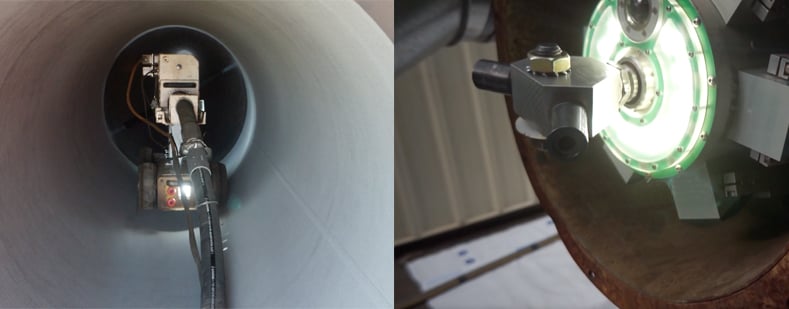Now more than ever, Contractors are looking for ways to save money, increase worker safety, and reduce waste. For abrasive blasting projects like cleaning tanks, prepping pipe internals, or blasting walls and floors, robotic abrasive blasting is often a better choice than manual blasting.
Using Sponge Media™ takes robotic abrasive blasting to the next level by further increasing control, productivity, and safety while reducing media consumption. According to Ed Zaharias, Senior Manager at Sponge-Jet, “If you want to reduce man hours inside of a confined space application, there are several things that Sponge Media does that no other grit will do.”
New tools for robotic abrasive blasting projects are being developed every year by a variety of companies. Several leading robotic blasting innovators have selected Sponge Media to be their abrasive of choice in part because of the reasons below…
Low Dust
Sponge Blasting generates up to 98% less dust than ordinary grit blasting. While this is an exceptional advantage for manual abrasive blasting, it especially aids in increased productivity and safety in robotic abrasive blasting. “Because blasting with sponge media produces less dust, operators can use cameras to monitor the blasting process without having someone in a confined space with the robot,” said Zaharias. These cameras allow for operators to have control over the blast pattern and robotic arm speed from a safe distance away. Sponge-Jet’s Robotica, for example, has forward and aft flush-mounted cameras for precise monitoring and control. Several other manufacturers of Sponge Media robotic blasters use high definition, zoom cameras to provide clear resolution of the surface being blasted and can provide real time footage of robot's activity.
Low Rebound
Sponge Media also has low rebound characteristics. “These low rebound characteristics of sponge abrasive media also allow the use of sensitive equipment on a robotic blasting unit that could otherwise get damaged from the high ricochet of traditional grits,” said Zaharias. Robotic units often rely on precision movements from mechanics that move or rotate. Grit intrusion (common with ordinary abrasive blasting) can damage these moving parts rendering components inoperable.
More Effective and Efficient Process
Whether being used in manual abrasive blasting or robotic blasting, Sponge Media has been shown to remove invisible contaminants that affect the life of a coating system. These contaminants include, but are not limited to soluble salts and hydrocarbons. Traditionally, these contaminants would have to be removed using a separate process before or after blasting. “This increases both time and man hours in a confined space. However, because Sponge Media often removes these contaminants during the blasting process and robotic blasting is six to eight times faster than manual abrasive blasting, man hours are greatly reduced,” said Zaharias.
In addition, because robotic blasting is a mechanical process, it is more precise and efficient than manual blasting where visibility, fatigue, and other factors contribute to inconsistencies. This increased efficiency results in less sponge media being consumed per square foot and generally leaves a whiter, cleaner, more uniform surface.
All in all, robotic abrasive blasting using sponge media is a perfect combination that makes even the most difficult job proceed more smoothly, efficiently and safely.
For more information on Robotic Abrasive Blasting, please see:
What are the Best Projects for Robotic Abrasive Blasting?
Is Robotic Abrasive Blasting Safer than Manual Blasting?
Is Robotic Abrasive Blasting Faster Than Manual Blasting?








